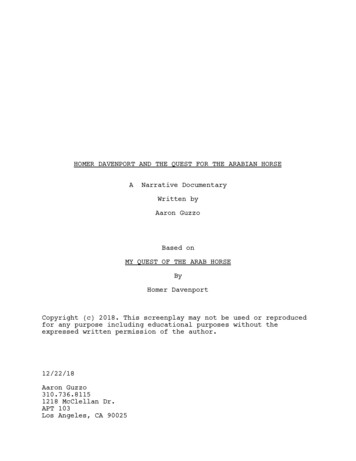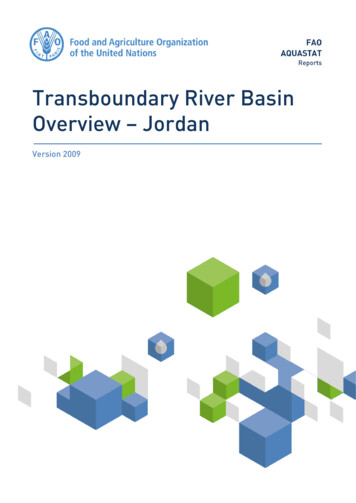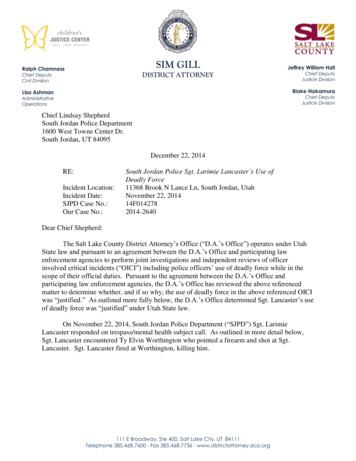
Transcription
UBRARVGEOLOGY OF THEARABIAN PENINSULAJordanGEOLOGICAL SURVEY PROFEIONAL PAPER 560-1
Geology of the Arabian PeninsulaJordanBy FRIEDRICH BENDERGEOLOGICAL SURVEY PROFESSIONAL PAPER 560-IPrepared in cooperation with theGove1·nment of Jordan and theGeological SuTvey of theFedeTal Republic of GermanyA review of the geology of Jordan) a supplementto USGS Miscellaneous Geologic Investigation Map1-270-A) ''Geologic map of the ArabianPeninsula/' 1963UN !TED STATES GOVERNMENT PRINTING OFFICE,V\'ASHINGTON1975
UNITED STATES DEPARTMENT OF THE INTERIORSTANLEY K. HATHAWAY, SecretaryGEOLOGICAL SURVEYV. E. McKelvey, DirectorLibrary of Congress Cataloging in Publication Data (Revised)Main entry under title:Geology of the Arabian Peninsula.(Geological Survey professional paper 560)Part of illustrative matter in p'ocket.Includes bibliographies.CONTENTS: B. Yemen, by F. Geukens.-C. Aden Protectorate, by J. E. G. W. Greenwood and D. Bleackley.-D. Sedimentary geology of Saudi Arabia, by R. W. Powers and others. [etc.]Supt. of Docs. no.: I 19.16:560-I1. Geology-Arabia. 2. Geology-Near East. I. Series: U. S. Geological Survey. Professional paper 560.QE75.P9 no. 560555.370-604863For sale by the Superintendent of Documents, U.S. Government Printing OfficeWashington, D.C. 20402Stock Number 2401-02547
FOREWORDThis volume, "The Geology of the Arabian Peninsula," is a logical consequence of thegeographic and geologic mapping project· of the Arabian Peninsula, a cooperative venturebetween the Kingdom of Saudi Arabia and the Government of the United States. The ArabianAmerican Oil Co. and the U.S. Geological Survey did the fieldwork within the Kingdom ofSaudi Arabia, and, with the approval of the governments of neighboring countries, a number ofother oil companies contributed additional mapping to complete the coverage of the whole ofthe Arabian Peninsula. So far as we are aware, this is a unique experiment in geologicalcooperation among several governments, petroleum companies, and individuals.The plan for a cooperative mapping project was originally conceived in July 1953 by thelate William E. Wrather, then Director of the U.S. Geological Survey, the late James TerryDuce, then "Vice President of Aramco, and the late E. L. deGolyer. George Wadsworth, thenU.S. Ambassador to Saudi Arabia, and Sheikh Abdullah Sulaiman, then Minister of Financeof the Government of Saudi Arabia, lent their support to the plan. In November of the following year, 1954, Director Wrather approved the U.S. Geological Survey's participation anddesignated G. F. Brown responsible for the western Arabian shield region in which he hadpreviously worked under U.S. foreign-aid programs. In January 1955 F. A. Davies, Chairman,Board of Directors, Arabian-American Oil Co., approved Aramco's participation and appointedthe late R. A. Bramkamp, chief geologist, respons!ble for compilation of the area within theKingdom where the sediments crop out. This responsibility fell to L. F. Ramirez followingthe death of R. A. Bramkamp in September 1958.R. A. Bramkamp and G. F. Brown met in New York in February 1955 and planned theprogram, including scales of maps, areas of respons'ibility, types of terrain representation,and bilingual names. Thus there was established a cooperative agreement between the Kingdom of Saudi Arabia, the U.S. Department of State, and the Arabian-American Oil Co. tomake available the basic areal geology as mapped by Aramco and the U.S. Geological Survey.The agreement specified publication o a series of 21 inaps on a scale of 1: 500,000, eachmap covering an area 3 of longitude and 4 of latitude. Separate geologic and geographicversions we e to be printed for each of the quadrangles; both versions were to be bilingual-inArabic and English A peninsular geologic map· on a scale of 1:2,000,000 was to conclude theproject.High-altitude photography, on a scale of 1: 60,000, of the Kingdom of Saudi Arabia wasinitiated during 1949 by the Aero Service Corp. and completed in 1959 . Both third-ordervertical and horizontal control and shoran were utilized in compiling the photography. Thiscontrolled photography resulted in highly accurate geographic maps at the publication scalewhich then served as a base for the geologic overlay. The topography of the sedimentaryareas was depicted by hachuring and that of the shield region by shaded relief utilizing theairbrush technique.The first geographic quadrangle was published in July 1956 and the last in September1962. While preparation of the geographic sheets was in progress, a need arose for earlypublication of a 1: 2,000,000-scale peninsular geographic map. Consequently, a preliminaryedition was compiled and published in both English and Arabic in 1958. The second edition,containing additional photography and considerable new topographic and cultural data, waspublished in 1963. The first of the geologic map series was published in July 1956 and thefinal sheet in early 1964. The cooperative map project was completed in October 1963 withm
IVFOREWORDthe publication of the 1:2,000,000-scale "Geologic Map of the Arabian Peninsula" (Miscellaneous Geologic Investigations Map I-270-A).As work on the quadrangles progressed, geologists, companies, and governments workingin areas adjacent to the Kingdom of Saudi Arabia were consulted by Aramco and invitedto participate in the mapping project. The number of cooperating participants was expandedto 11, which included the operating oil companies in the peninsula and which are identifiedelsewhere in this text; the Overseas Geological Surveys, London; the Government of Jordan;F. Geukens, who had worked in Yemen; and Z. R. Beydoun, who had studied the EasternAden Protectorate. With the close cooperation of the authors the new data were added todata already plotted on the base map of the Arabian Peninsula.As the geological coverage of the peninsular map grew, the need for a text to accompanythe map became apparent to both the U.S. Geological Survey and the Aramco geologists.Exploratory conversations were begun by Aramco with companies working in the other countriesof the Arabian Peninsula for their participation in the preparation of a monograph on thegeology of the Arabian Peninsula. Each author prepared a description of the geology of thearea for which he was responsible, as shown in the sources of geologic compilation diagramon the peninsular map. The U.S. Geological Survey undertook the publishing of the volumeas a professional paper, and the Government of. Saudi Arabia was to finance its printing.It was early agreed that there would be no effort to confine the contributions to a standardformat and that no attempt would be made to work out an overall correlation chart otherthan shown on the "Geologic Map of the Arabian Peninsula." Thus, the individual styleof authors of several nationalities is preserved.Cooperation and relations ·have been of the highest order in all phases of the work. Theproject would not have been possible without the full support of the U.S. Department of State,the Kingdom of Saudi Arabia, and all contributors. In fact, the funds which made publication of this volume possible were contributed by the Saudi Arabian Government.The data provided by the maps and in the professional paper provide information foran orderly scientific and economic development of a subcontinent.w. D. JOHNSTON, JR.,F01·mer Chief, Foreign Geology Branch,U.S. Geological Survey.NOTE:As stated in the introduction, this report is based essentiallyon geologic data available in 1967 and incorporates stratigraphicand structural data resulting from investigations, sponsored bythe United Nations Food and Agriculture Organization, ofground water and mineral resources from 1964 to 1969. Sincethen the Mining Division and the Department of Water Resources Authority in Jordan have undertaken extensive drillingand geophysical and geologic exploration programs which haveyielded additional critical information. These data substantiateand refine the interpretation of several potential petroleumbearing sedimentary basins, demonstrate large amounts of several metallic and nonmetallic mineral resources, and to someextent modify the tectonic-stratigraphic framework presentedhere.With the new data, M. Malhas (1974, The tectonic andstratigraphic framework of Jordan and its implications regarding potential hydrocarbon accumulation: Jordan Nat. ResourcesAuthority rept., in press) has synthesized the tectonic-stratigraphic relationships, documenting the presence of basins ranging from Paleozoic to Tertiary, and described the petroleumgeology. V. E. Swanson (1974. Recommendations for the .study0. A. SEAGER,Arabian-Anwrican Oil Co. (Retired).and appraisal of oil shale -depositS in ·Jordan: U.S. Geol. ·Surveyopen-file rept.) evaluated the oil shale resources and developmentprograms of Jordan and concluded that the inferred reserveswere very large. Recent work by the Natural ResourcesAuthority (1972, The mineral prospects of Jordan: Jordan Nat.Resources Authority Mining Div., unpub. rept., 22 p.) indicates "prospective reserves" as large as 10 billion metric tonsof shale containh1g 1 bbl/metric ton ( p. 20). Y. F. Nimry(1973, The copper and manganese prospects of Wadi Araba:Jordan Nat. Resources Autharity Rept. on Phase One, 107 p.and map) reported on an extensive exploratory program bythe Mining Division of the Natural Resources Authority; largeresources of copper and manganese have been identified in thevicinity of Fayniin on the east side of Wadi al 'Arabah. Otherstudies by the Mining Division indicate large resources of several nonmetallic minerals. More recent information on theavailability of phosphate, glass sand, clay, tripoli, gypsum,ceramic and construction materials, and saline deposits are alsoavailable from the Natural Resources Authority (1972).Project reports on investigations of these resources are onfile in the Jordan Natural Resources Authority, Amman.
CONTENTSPageForevvord ---------------------------------------Abstract n ------------------------------------Scope of contribution -----------------------Previous vvork ------------------------------Acknovvledgments ---------------------------General geomorphology --------------------------Geologic history and paleogeography --------------Precambrian basement complex -------------------n[etamorphic rocks --------------------------Igneous rocks -------------------------------Upper Proterozoic sedimentary rocks --------Upper Proterozoic-Paleozoic volcanic andassociated rocks ---------------------------Post-Proterozoic stratigraphy and volcanism -------Paleozoic Era -----------------------------------n[esozoic Era -----------------------------------Mesozoic volcanic rocks ----------------------Cenozoic Era -----------------------------------Cenozoic volcanic rocks 202022Page12323Structure ---------------------------------------Wadi al 'Arabah-Jordan Rift ----------------Nubo-Arabian Shield in southern Jordan ------Block faults in central and southeastern JordanUpwarping, tilting, and block faulting innorthern Jordan -------------------------Anticlinorium, upvvarping, and block faultingvvest of the Jordan River -----------------Economic geology -------------------------------Aquifers ------------------------ -----------Oil and gas, bituminous rocks, and asphalt ----Metallic minerals ----------------------------Copper ---------------------------------Manganese -----------------------------Iron -----------------------------------Chromium, nickel, uranium, and pyrite ----Nonmetallic minerals ------------------------Phosphate ------------------------------Other minerals --------------------------Selected references -------------------------------24252525 52526272727292929293134ILLUSTRATIONS[Plates are in pocket]PLATE1.2.3.Geologic map of Jordan.Correlation chart of lithostratigraphic units in Jordan.Structure contour map of the top of the Precambrian rock complex,Jordan.PageFIGURES1.2-10.11.Index map shovving physiographic-geologic provinces in JordanPhotographs shovving:2. Precambrian granodiorite and dikes and overlying Cambrian sandstone, southern Jordar. -----------------3. Cambrian and Lovver Ordovician sandstone, southernJordan -----------------------------------------4. Middle and Upper Ordovician sandstone and shale,southern Jordan --------------------------------5. Beginning of flexure in Upper Cretaceous limestone andmarl, Dead Sea area ----------------------------6. Outlier 'j.'uvvayyil ash Shihaq, central Jordan -------7. Basalt flovv cracked by insolation, northeast Jordan --8. Aerial vievv of vvadis and mudflats that follovv structural pattern, northeast Jordan ------------------9. The Wadi al 'Arabah-Jordan Rift at its lovvest point10. Upper Cretaceous rocks, vvestern edge of Wadi al'Arabah-Jordan Rift ----------------------------Paleogeographic map of Jordan ----------------------------1455666788910v
VICONTENTSPageFIGURES12-15.16.17.18.19.Photographs showing:12. Biotite schist in aplite granite ---------------------· 13. Aerial view of mafic, intermediate, and silicic dikes,southern Jordan --------------------------------14. Angular unconformity between the upper ProterozoicSlate-Graywacke Series and Cambrian sandstone --15. Intrusion of quartz porphyry into Cambrian sandstoneComposite columnar section of Cretaceous and Paleozoic sedimentary rocks in south Jordan --------------------------Map showing occurrences and indications of minerals and rocksof economic interest and locations of oil exploration wells inJordan th-south correlation of Upper Cretaceous-lower Tertiarylithostratigraphic units --------------------------------Photograph showing phosphate in open-pit mine ------------11213131415283031
GEOLOGY OF THE ARABIAN PENINSULAJORDANBy FRIEDRICH BENDERABSTRACTThe Hashemite Kingdom of Jordan covers an area of approximately 96,500 km 2 in the northwestern part of theArabian Peninsula.In southwestern Jordan, part of the Nubo-Arabian Shieldis exposed. It is characterized by Precambrian plutonic andmetamorphic rocks, and by some minor occurrences of upperProterozoic sedimentary rocks. Cambrian, Ordovician, andSilurian sandstone and shale of continental and marine origin have a maximum thickness of 1,800 m and unconformably overlie the rocks of the Precambrian basement complex.A belt of sedimentary rocks deposited chiefly on the stableshelf area of the Tethys Sea borders the northern fringe ofthe shield. Most of southeastern and central Jordan is withinthis belt. It is a zone of interfingering sedimentary rocks ofcontinental, littoral, and neritic origin, rapid lateral facieschanges, and many stratigraphic unconformities caused bypulsation and, at certain periods, transgression and regression of the Tethys Sea. Regionally, the marine influence onthe deposition increases toward the north and west. The totalthickness of all post-Proterozoic sedimentary rocks is2,000-3,000 m; it exceeds 4,000 m in the baylike sedimentarybasin of AI Jafr in south-central Jordan, and 5,000 m in theAI Azraq-Wadi as Sirl)an Basin in north-central Jordan.These basins strike northwest and thus seem to merge withthe unstable shelf area of the Tethys Sea in the northwest.In the transition zone to, and in the area of, the unstableshelf in northwestern, northern, and probably northeasternJordan, neritic and bathyal sedimentary rocks form the major part of the post-Paleozoic rocks. Here, the stratigraphicsequence is more complete, unconformities are fewer, andlateral facies changes are less pronounced than in the stableshelf area to the south and southeast. In northwestern J ordan, west of the Jordan River, the total thickness of sedimentary rocks above the Precambrian basement may be asmuch as 7,000 m; in the Dead Sea area of the Wadi al'Arabah-Jordan Rift province, repeated structural subsidenceresulted in the accumulation of sedimentary rocks as muchas 10,000 m thick.No evidence is known of post-Proterozoic structural movements characteristic of alpine orogenesis. The crustal movements affecting the country since the Cambrian were gentleregional tiltings (epeirogenic movements) and a combinationof faulting, block folding, and taphrogenic movements. The1Geoloirical Survey of the Federal Republic of Germany.1majority of structural features were caused by tensionalforces. Evidence of compression is rare and chiefly restrictedto west Jordan and to north Jordan east of the Rift.Major volcanic activity occurred during the late Proterozoic and Early Cambrian (quartz porphyries, Wadi al 'Arabah), during the Late Jurassic ( ?) and Neocomian (maficand intermediate eruptive rocks, Wadi al 'Arabah and westof the Jordan River), and during the Neogene (includesMiocene and Pliocene as used in this report) and Pleistocene(extensive basalt volcanism).INTRODUCTIONSCOPE OF CONTRIBUTIONThis report describes the geology of that part ofthe northwestern Arabian Peninsula, the HashemiteKingdom of Jordan, which was mapped by a geological mission of the Geological. Survey of the FederalRepublic of Germany, 1961-67. The mapping wasdone at scales of 1: 25,000, 1: 60,000, and 1: 100,000and later compiled at a scale of 1:250,000 (Benderand others, 1968). This map differs in certain areasfrom Quennell's (1966) geologic map of Jordaneast of the Wadi al 'Arabah-Jordan Rift, whichcovers approximately the western half of Jordan,and which was incorporated in the 1: 2,000,000-scalegeologic map of the Arabian Peninsula (U.S. Geological survey and Arabian-American Oil Company,1963).The geographic names in this report conform tothe Jordan Gazettee,r of 1971, which lists names approved by the U.S. Board on Geographic Names;however, for several names the more popular spelling is given in parentheses both in the report andon plate 1.PREVIOUS WORKThe literature dealing with the geology of Jordanis surprisingly extensive. It has been recently compiled, and an account of the history of geological11
I2GEOLOGY OF THE ARABIAN PENINSULAresearch has been given by Bender (1968a). Therefore, only some significant publications are citedherein.Seetzen (1810) gave one of the first accounts ofa geographic reconnaissance survey: he lost his lifeon his last expedition (Kruse, 1854-55). In 1837,von Schubert and Roth discovered that the DeadSea level is considerably lower than the level ofthe Mediterranean (Hull, 1886, p. 12). Berton(1839) is reputed to have been the first travellerto travel the length of the Wadi al 'Arabah fromthe Dead Sea to the Gulf of Aqaba. Russegger(1847) made several expeditions to the "Holy Land"and published a "geognostic" map of Arabia Petraea. Under the leadership of U.S. Navy Lt. Lynch(1852), a survey was undertaken to explore theDead Sea and the River Jordan. Later, Ritter(1848-55), vom Rath (1881), Fraas (1867a, b),Milne (1875), and Lartet (1876) discussed geologic problems of the Jordan area. The contributionsof Hull (1886) incorporated many detailed recordson geologic observations and a geologic map ofWadi al 'Arabah.From about 1890 to 1914, Max Blanckenhorn wasengaged in geologic research in Palestine andTransj ordan. He achieved a comprehensive knowledge of the country and documented his observations in many publications (Blanckenhorn, 1903,1912, 1914). During that time, the Hejaz RaHroadfrom Damascus (Syria) via 'Amman. Ma'an, and AIMudawwarah to AI Madinah (Saudi Arabia) wasplanned and constructed. The area thus becamemore accessible, and geologic research increased COnsiderably (Auler, 1908; Musil, 1907, 1911: Krusch,1911; Dienemann, 1915; Fuchs, 1916 ·, Kober, 191 9 ·,Schwobel, 1921).During the period of the British Mandate, King(1923), Cox (1924, 1925, 1932, 1934), Muir-Wood( 1925) ' W agner (1934) ' R'lCht er an d R'lCht er(1941)' and Avnimelech (1945) published reportsthI t Jf C b T one pa eon 0 ogy 0am rian,riaSSIC, andJurassic rocks. Regional geologic problems were disd b Kk J ( 1924 1925cussey ren e'' 1941) and Hennig(1938). G. s. Blake, as geologist of the BritishM d t Gt dan a e overnmen , Carne OUt Systematic SUrVeys On mineral and ground-water reSOUrCeS andd d h fi d'·recor e IS n Ings In m·any contributions (Blake,1928, 1930, 1936, 1939; Ionides and Blake, 1939;Blake and Goldschmidt, 1947). Blake lost his life.while on a field survey in the Wadi al 'Arabah.Willis ( 1928) and Wellings (in Willis, 1938) investigated problems On the evolution of the JOrdanRift. Structural phenomena were also discussed byDubertret (1932), who also published geologic mapsof the region (Dubertret, 1959, 1962). Since 1928,important contributions to the knowledge of thegeology in the Jordan area have been made byPicard (1928, 1931, 1941, 1943, 1953, 1965).Shaw (1947, 1948) published a geologic map ofsouthern Palestine and 'gave an account on thegeology and mineral resources of Palestine. A similar contribution was made by Quennell (1951, 1956)for the territory of Transjordan. Quennell's mapsand geologic findings formed the main basis of Burdon's "Handbook of the geology of Jordan . . . "(1959). A significant contribution, especially onstratigraphic correlation, was published by Wetzeland Morton (1959).During the last 20 years, geologic consulting thatconcerned projects for economic development hasplayed an increasing role. Generally, the resultsare in unpublished reports for the Government ofJordan-for example: Reports of the TransjordanPetroleum Development Co., Ltd. (1947-49) 2 ; E. W.Pauley Oil Exploration and Phillips Petroleum Co.(1956-60) 3 ; J. W. Mecom Oil Co. (1964-66) 4 ;Mackay & Schnellmann (1954, 1957) 56 ; ParsonsCorp. (1963)1; Gold (1964) 8 ; Wilson and Wozab(1954) ; Baker and Harza Engineering Co. (1955) 9 ;Hunting Technical Services, Ltd. (1956, 1965) 10 11 ;Sir M. Macdonald & Partners (1965)1 2 ; Rofe &Raffety Consultant Engineers (1963, 1965) 13 14 ; the2Transjordan Petroleum Development Co., Ltd . 1947-49, Unpub. repts.,Jordan Nat. Resources Authority, Amman, Jordan.3 E. W. Pauley Oil Exploration and Phillips Petroleum Co., 1956-60,Unpub. repts . Jordan Nat. Resources AuthoritY, Amman, Jordan.4J. W. Mecom Oil Co., 1964-66, Unpub. repts., Jordan Nat. ResourcesAuthority, Amman, Jordan.5Mackay & Schne!lmann, 1954, Mineral resources in Jordan: London,Mackay, L Schnellmann Consulting Economic Geologists, unpub. rept.6 Mackay & Schnellmann, 1957, Phosphate resources in Jordan, Roseifa:London, Mackay & Schnellmann Consulting Economic Geologists, unpub.re arsonsCorporation, 1963, Exploration and geology, v. 2 of El Hasaphosphate project: Los Angeles, Calif., Parsons Corp. Engineering, unpub.rept. 3166-1, Jordan Nat. Resources Authority, Amman, Jordan.8 Gold, 0., 1964, The Wadi Araba copper exploration, Jordan-reporton phase A: KO!n, Germany, Ingenieurberatung fiir Bergbaufragen, unpub. rept. for Jordan Government, Jordan Devel. Board, Amman, Jordan.11 Baker, M., and Harza Engineering Co., 1955, Yarmouk-Jordan Valleyproject, master plan report: Unpub. rept. for the Jordan Government,Jordan Nat. Resources Authority, Amman, Jordan, v. 1-13.10 Hunting Technical Services, Ltd., 1956, Range classification surveyof the Hashemite Kingdom of Jordan: London, Hunting Tech. Services,Ltd., unpub. rept., Jordan Nat. Resources Authority, Amman, Jordan.n Hunting' Technical Services, Ltd., 1965, Wadi Dhuleil investigation:London, Hunting Tech. Services, Ltd., unpub rept., Jordan Nat. Resources Authority, Amman, Jordan.12 Sir M. Macdonald &Partners, 1965, East bank Jordan water resources, summary report: Sir M. Macdonald & Partners, unpub. rept. for ·da: rdan Government. Jordan Nat.ResourcesAuthority,Amman,13Rofe & Raffety Consultant Engineers, 1963, Jerusalem and districtwater supply, geo!ogical and hydrological report: London, Rofe & RaffetyCons. Engineers, unpub. rept. for Jordan Central Water Authority.14Rofe & Raffety Consultant Engineers, 1965, Nablus district water resources survey: London, Rofe & Raffety Cons. Engineers, unpub. rept.for Jordan Central Water Author ty.
JORDANreports of the United Nations Food and AgricultureOrganization (UNFAO) "Sandstone Aquifer Project in southeast-Jordan"; Lloyd (1969) ; Parker(1969) ; and the reports of the German GeologicalMission (1961-67).ACKNOWLEDGMENTSThe author wishes to express his appreciation andthanks to Mr. 0. A. Dokhgan, the general directorfor many years of the Natural Resources Authorityof the Hashemite Kingdom of Jordan, who promotedall efforts concerning geologic research in Jordan.The author furthermore greatly appreciates andthanks his colleagues of the German geologicalmission who shared in the field and office work inJordan from 1961 to 1967: A. Abdullatif, D. S.Ahmad, G. van den Boom, R. Busse, F. Z. Dajani, A.Futian, J. Grieger, F. Griineberg, M. Haddadin, W.Heimbach, H. Ibrahim, K. Jeresat, K. M. Khdeir,M. Lahloub, R. Lenz, W. Lillich, M. Nuseibeh, M.Ruef, S. S. Salem, 0. Suwwan, B. F. Sunna, Z.Tuqan, and G. Wiesemann.Special acknowledgment goes to Mr. W. Barber,project manager of the UNF AO "Sandstone AquiferProject in southeast-Jordan" for many discussionsrelated to the geology of Jordan; and for access tohis unpublished material.Naturally, this paper incorporates results of workby many more geologists who were involved in thecollection and processing of data presented here.Each of these contributions is cited individually.GENERAL GEOMORPHOLOGYThe Hashemite Kingdom of Jordan covers anarea of approximately 96,500 km 2 in the northeastern part of the Arabian Peninsula. In contrast tothe more uniform and monotonous morphology ofmost of the interior of the Arabian Peninsula, thewestern and northwestern parts, including the territory of Jordan, are morphologically distinctive.Jordan may be divided into seven physiographicprovinces, which coincide with geologic provinces(fig. 1) :Southern Mountainous Desert ;Mountain Ridge and Northern Highlands Eastof the Rift;Central Plateau (includes AI Jafr and AI AzraqWadi as Sirgan Basin);Northern Plateau Basalt;Northeastern Plateau;Wadi al 'Arabah-Jordan Rift;Highlands West of the Rift.13The Southern Mountainous Desert occupies thearea south of the west-northwest-striking escarPment of Ra's an Naqb, and extends southward intoSaudi Arabia. Between AI 'Aqabah and AI Quwayrahwhere igneous rocks of the Precambrian basementare exposed, the country is rough, and steep mountains rise to 1,550 m above sea level (fig. 2). Farthereast, Paleozoic and Mesozoic sandstone overlies thePrecambrian basement complex, and from KawrRamm (Wadi Ramm) to the east they cover it completely. The sandstones also form steep bizarre cliffs(fig. 3) and mountains more than 1,700 m in altitude (Jabal Ramm, 1,754 m). Closer to the djsusedHejaz Railroad (AI Mudawwarah) and farther east(Jabal at Tubayq), an inselberg landscape of tablemountains and large depressions are the dominanttopographic features (fig. 4). Broad, generally flatareas near the base level of erosion indicate thatthe mature stage of the arid erosion cycle has beenreached in this region. The debris of arid weathering, drifting sand, and pelitic sediments in extensive mudflats cover the depressions and form verythick fill in erosion channels of the Pleistocenepluvial periods. Drainage in the western part ofthis physiographic province is to the south intothe Gulf of Aqaba and is still actively cutting headward. In the eastern part, drainage turns southeastinto the flats south of AI Mudawwarah and east intoWadi as Sirgan Basin.The Mountain Ridge and Northern Highlands Eastof the Rift is a coherent physiographic feature, inspite of its varied geologic character. It stretchesnorth-northeast to north for about 370 km fromthe Gulf of Aqaba to Lake Tiberias; in general,it slopes gently toward the Central Plateau in theeast, whereas it slopes very steeply toward theRift province in the west (fig. 5). Because the baselevel of erosion in the Rift province has been loweredby continuing structural subsidence, the westwarddrainage of the Mountain Ridge province has beenrejuvenated frequently. Thus, the streams have cutfa!'ther and farther eastward into the CentralPlateau, capturing additional areas for the drainage basin of the Rift (Burdon, 1959, p. 12). Thehighest altitudes in the country (about 1,850 m)are in the southern part of the Mountain Ridgeprovince, in the Jibal ash Sharah.The Central Plateau is bordered on the west byslopes that rise westward to the Mountain Ridgeprovince : in the north and in the east, the CentralPlateau falls to the flat, wide southeast-striking AIAzraq-Wadi as Sir an Basin, which includes theoasis of AI Azraq in its northeastern part. The hori-
GEOLOGY OF THE ARABIAN PENINSULA14,',/',' ,/,'/\,'\\\\/'/',r"'.(I(I.c.I.0,, .'/-,,'IllIII\Northern Plateau Basalt./:) /.---.J. ,Ic/: / \", .c;il\S' ' " \ .\ . ' , . I\ · -:sc:il,III" //.-.c:il.'' l1, .,. --\\//1'1!,"' .:.:.:-;-.- .---.III-""Central Plateau\(includes AI Jafr and AI Azraq- ··-.,Wadi as Sirl)an Basins). ," ·.',\ \"c;il,iS' \' ·.\.-\ · . .' ,,·- \--, \ ·. \ / . \\- -- ·\ \IAI Jafr Basin\-- I./.:.::.--"""',---------;','\ \en 'zz 'I0'Ta'' . s a g!? , --Sou th ern-- ./---I.II'\··.,, \\··.\' ].,I:\\',J--'-.I'-oesert\j/I· .\\I'Mountainoust,/1(II----- - ------------ ./\. .1--New,,t I---!!!:!:! a!,!onat b- - - - .0- ---.2!:,d.!r.1 , "'/--7'--500FIGURE10050nal'o't e , , . \f'te'f' natiO .,. .150 KILOMETRES100 MILES1.-Index map showing physiographic-geologic provinces, Jordan.,.,,I\96 -.-'. -.,. /. --\'.1-.J\I'"'i/. c;il9\(J:\\\)\(.,. . ""'-.\/ /---. , \// / \.\\ ,.;',',- r-, '\Northeastern Plateau )( .Q)2'---1,,"" /Q).c.{\,/"\. . .,.,I'\\\/}'\\\,'/, .,'\.
JORDANFIGURE152.-Precambrian granodio
This volume, "The Geology of the Arabian Peninsula," is a logical consequence of the geographic and geologic mapping project· of the Arabian Peninsula, a cooperative venture between the Kingdom of Saudi Arabia and the Government of the United States. The Arabian American Oil Co. and the U.S. Geological Survey did the fieldwork within the .









